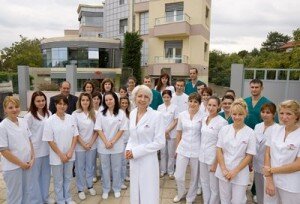The Dentaprime Clinic has looked after approximately 6,000 implant patients over the course of its five-year history. It has also monitored the success and healing rates of these implants, since the clinic believes that critical examination of the subject is vital for providing patients with the best possible care. Last year, Peter, one of the Dentaprime Clinic’s first ever implant patients, returned to the clinic to get an expert opinion five years on.
 Peter was 50 when he visited the Dentaprime Clinic for the first time in 2006. He was worried about his upper left lateral incisor, which had already received multiple root canal treatments and was cracked as a result of a minor accident. Since, as a self-employed business owner, he didn’t want to go through any long-winded treatment procedures, only one solution would do: extracting the tooth and carrying out an immediate implant. He had read about immediate implants in the newspaper and was enthusiastic about the advantages. The quickness of the procedure, in particular, was an encouraging factor – he wouldn’t be required to spend time with an unsightly gap. “We examined the patient’s dental situation and made sure the prerequisities were in place,” says Dr. Regina Schinjalova, director of the Dentaprime Clinic. “After we had compiled our clinical results, there was nothing standing in the way of an immediate implant.”
Peter was 50 when he visited the Dentaprime Clinic for the first time in 2006. He was worried about his upper left lateral incisor, which had already received multiple root canal treatments and was cracked as a result of a minor accident. Since, as a self-employed business owner, he didn’t want to go through any long-winded treatment procedures, only one solution would do: extracting the tooth and carrying out an immediate implant. He had read about immediate implants in the newspaper and was enthusiastic about the advantages. The quickness of the procedure, in particular, was an encouraging factor – he wouldn’t be required to spend time with an unsightly gap. “We examined the patient’s dental situation and made sure the prerequisities were in place,” says Dr. Regina Schinjalova, director of the Dentaprime Clinic. “After we had compiled our clinical results, there was nothing standing in the way of an immediate implant.”
Preparations for the implant began with the removal of the affected tooth. “The extraction was carried out in a particularly gentle way, to ensure that the surrounding soft tissue was not damaged,” says Dr. Schindjalova.
Although precise implant planning was possible at the time of Peter’s treatment, it wasn’t carried out to the high technical standard it is today. Nevertheless, working carefully, the team were able to determine the correct position for the implant and insert it accordingly. Likewise, although the subsequent process of impression-taking didn’t meet today’s standards, it was carried out with the utmost degree of care and precision. The model created from the impression was placed in an articulator to determine the optimal shape for the dental prosthesis. “Back then, many of the steps that are now accomplished digitally were still carried out manually,” says Dr. Schindjalova. “The main difference is that it took a lot more time.”
After the insertion of the implant, the patient was fitted with a long-term temporary denture to avoid placing too much initial load on the implant. There were two other key reasons for doing this: firstly, the extraction of the tooth had left a larger hole in the jaw than could be filled by the implant, so the team filled the remaining space with bone material collected during the preparation process; this material required time to heal prior to the final restoration being fitted. Secondly, like the bone material, the soft tissue also needed some time to recover before the final step.
Around five months later, when the implant was capable of withstanding the pressure, Peter returned to Bulgaria to have a crown fitted. At Peter’s request, the team used a gold crown with ceramic cosmetic veneer. Before being fitted, the colour of the crown was adjusted to match that of the existing teeth.
Last year – five years after the treatment – Peter was in Bulgaria for a holiday and took the opportunity to have the site and condition of the implant assessed at the Dentaprime Clinic. He was still as satisfied as he had been on the first day, when his ability to bite down firmly – without worrying about his cracked tooth – had been restored. The specialists at the Dentaprime Clinic were satisfied, too: “Neither the site nor the condition of the implant had altered at all during this time,” says Dr. Schindjalova. “During these past 5 years, the patient has displayed no signs of inflammation around the implant site and there has never been any risk of losing the implant.”
The visual effect has likewise remained unchanged. The prosthetic tooth blends perfectly into the existing dentition and cannot be identified as artificial. After a re-assessment of the situation using digital tomography, the patient was able to leave the clinic content in the knowledge that the implant was still intact and functioning well.
At the Dentaprime Clinic, cases like Peter’s are the norm: our success/healing rates lie at over 97 per cent. Although long-term studies into implants are currently insufficient in number, the anecdotal evidence accumulated by the high qualified and experienced team at the Dentaprime Clinic speaks for itself and for the high standard of implant treatment. Implants are by far the most effective way to remedy tooth loss – the only requirements are a skilled clinician and high-quality materials.


